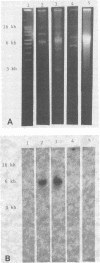Abstract
Two Clostridium butyricum strains from infant botulism cases produce a toxic molecule very similar to C. botulinum type E neurotoxin. Chromosomal, plasmid, and bacteriophage DNAs of toxigenic and nontoxigenic strains of C. butyricum and C. botulinum type E were probed with (i) a synthesized 30-mer oligonucleotide encoding part of the L chain of type E botulinum toxin and (ii) the DNA of phages lysogenizing these cultures. The toxin gene probe hybridized to the chromosomal DNA of toxigenic strains but not to their plasmid DNA. All toxigenic and most nontoxigenic strains tested were lysogenized by a prophage on the chromosome. Prophages of toxigenic strains, irrespective of species, had related or identical DNAs which differed from the DNAs of prophages in nontoxigenic strains. The prophage of toxigenic strains was adjacent or close to the toxin gene on the chromosome. Phage DNAs purified from toxigenic strains did not hybridize with the toxin gene probe but could act as the template of the polymerase chain reaction to amplify the toxin gene. The toxin gene was not transferred between C. botulinum and C. butyricum (either direction) when different pairs of a possible gene donor and a recipient strain were grown as mixed cultures. Nontoxigenic C. butyricum or C. botulinum type E-like strains did not become toxigenic when grown in broth containing the phage induced from a toxigenic strain of the other species.(ABSTRACT TRUNCATED AT 250 WORDS)
Full text
PDF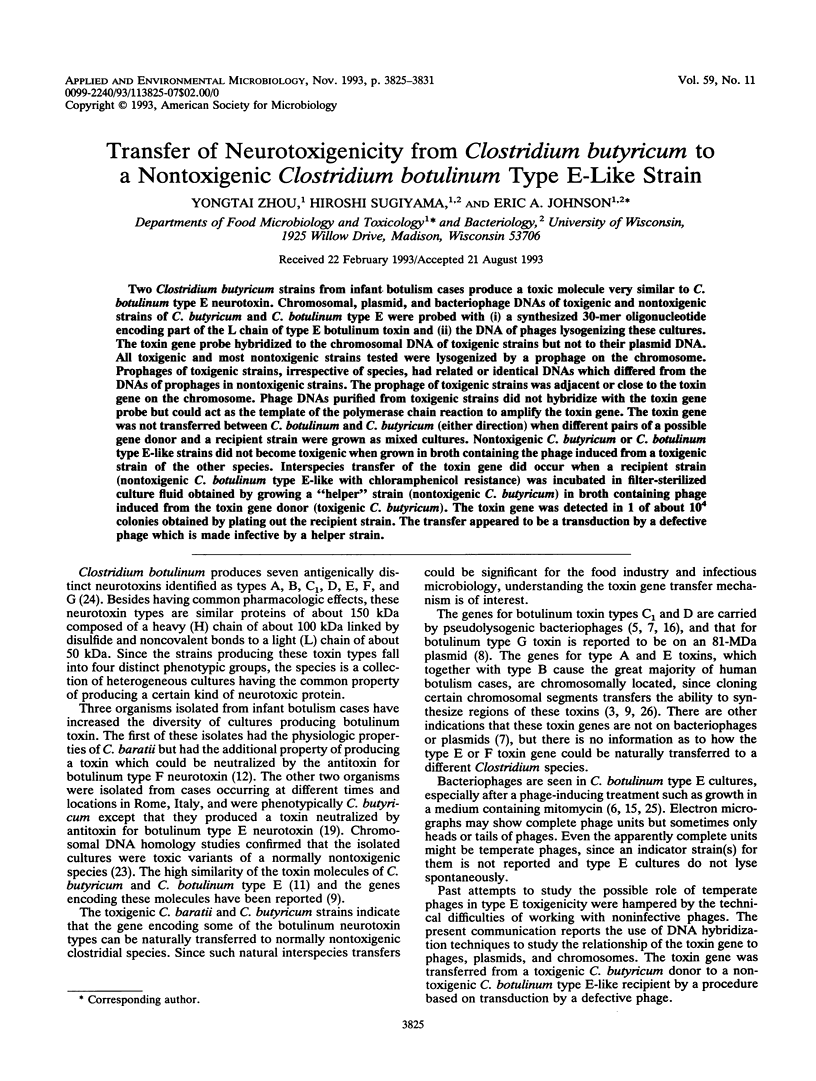
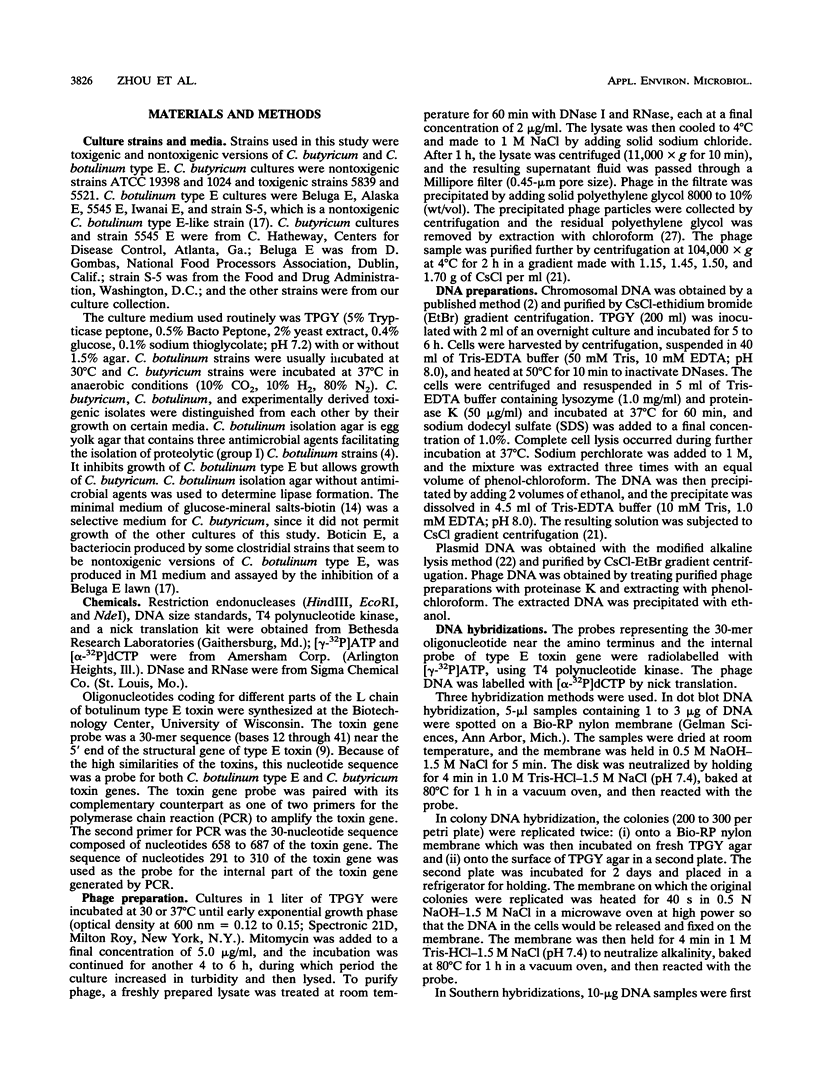
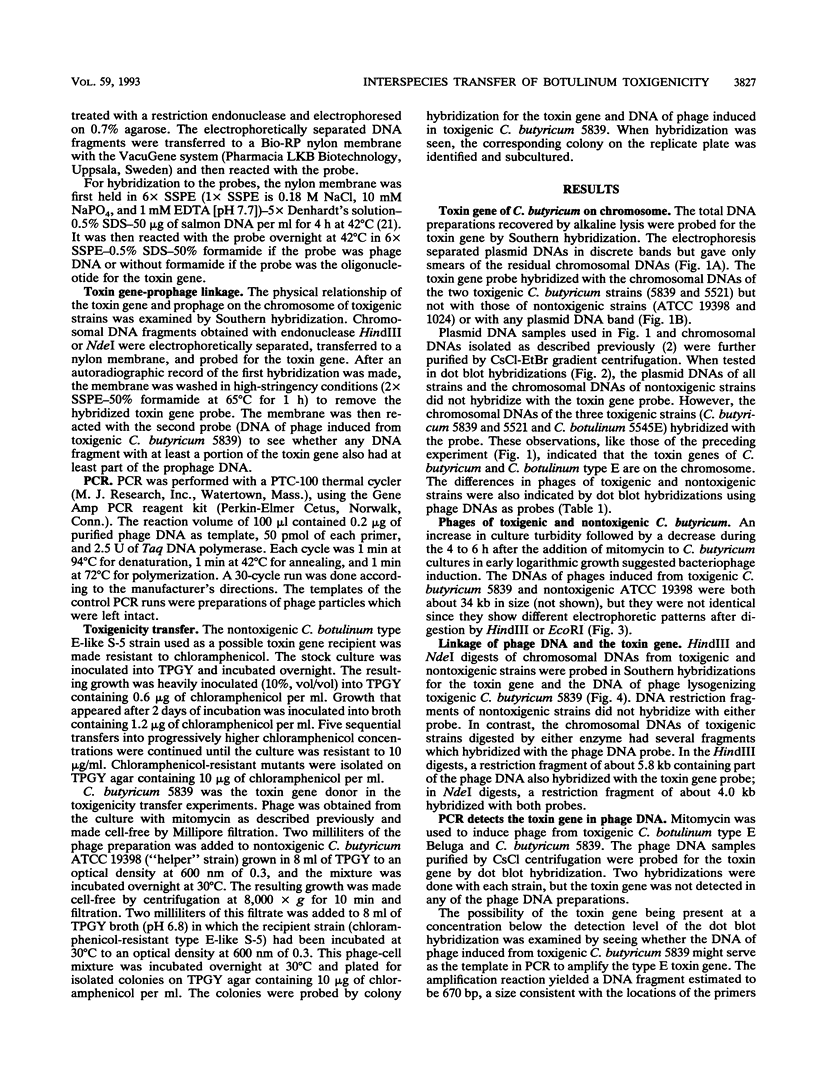
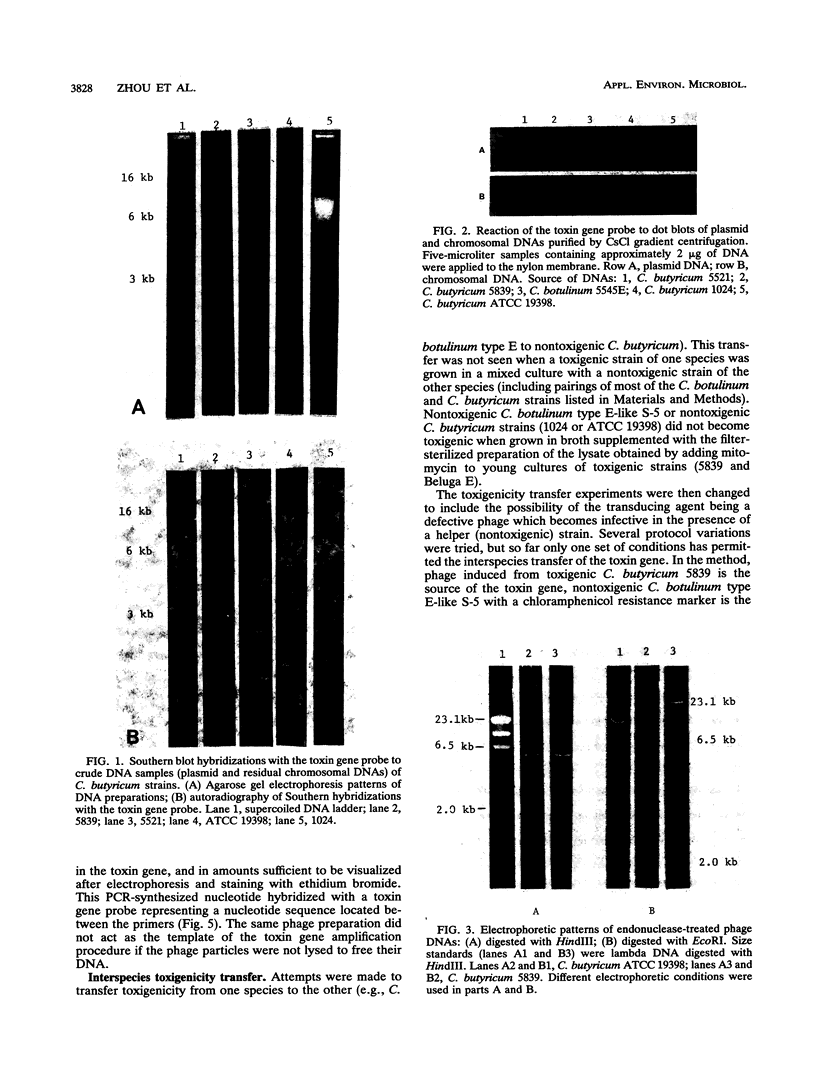
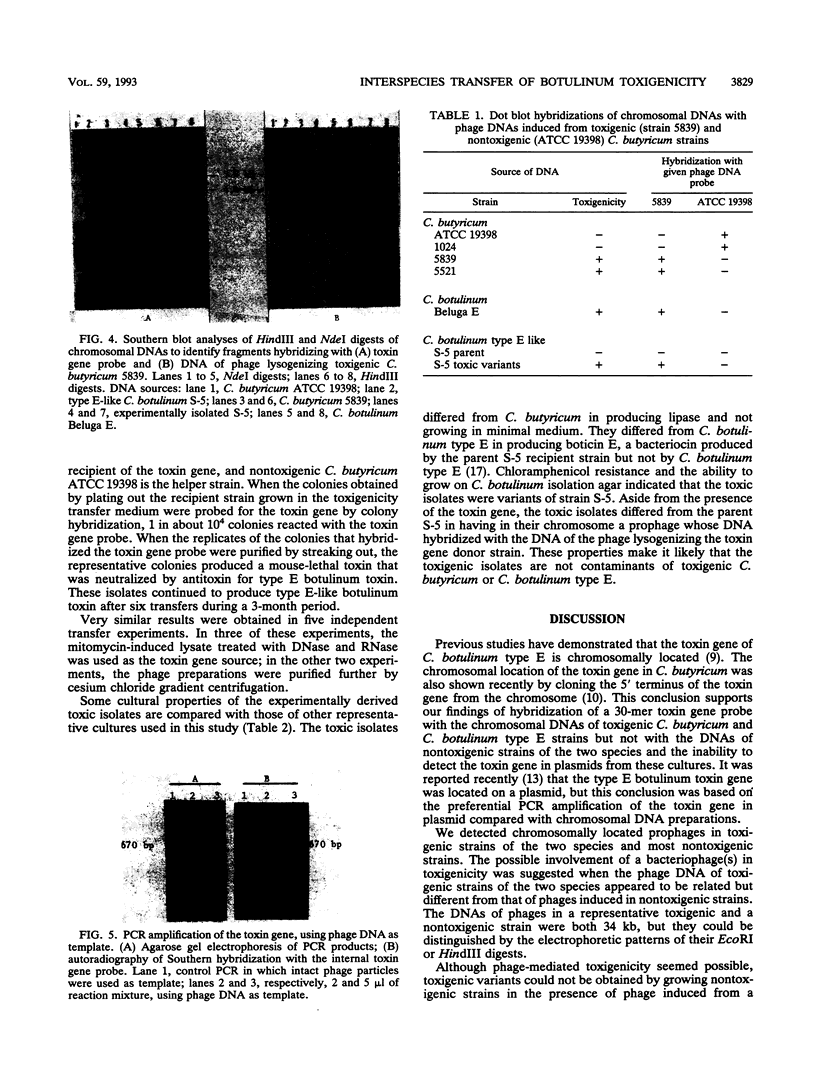
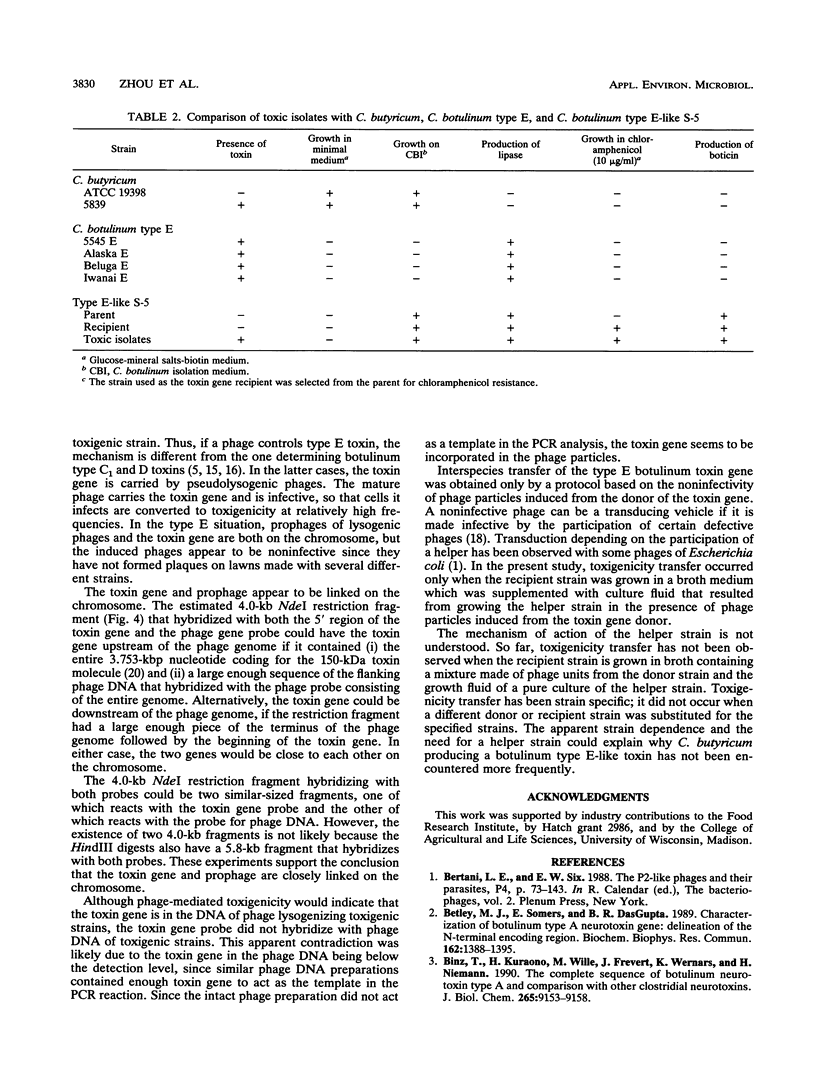
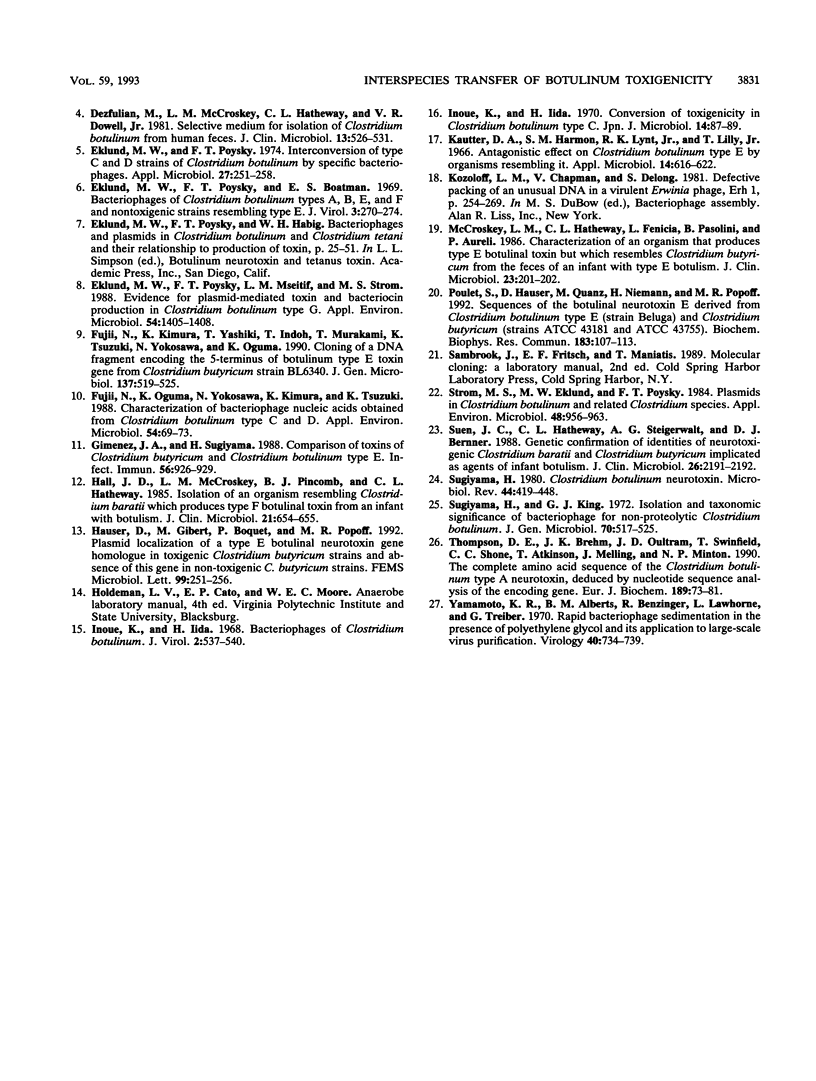
Images in this article
Selected References
These references are in PubMed. This may not be the complete list of references from this article.
- Betley M. J., Somers E., DasGupta B. R. Characterization of botulinum type A neurotoxin gene: delineation of the N-terminal encoding region. Biochem Biophys Res Commun. 1989 Aug 15;162(3):1388–1395. doi: 10.1016/0006-291x(89)90828-0. [DOI] [PubMed] [Google Scholar]
- Binz T., Kurazono H., Wille M., Frevert J., Wernars K., Niemann H. The complete sequence of botulinum neurotoxin type A and comparison with other clostridial neurotoxins. J Biol Chem. 1990 Jun 5;265(16):9153–9158. [PubMed] [Google Scholar]
- Dezfulian M., McCroskey L. M., Hatheway C. L., Dowell V. R., Jr Selective medium for isolation of Clostridium botulinum from human feces. J Clin Microbiol. 1981 Mar;13(3):526–531. doi: 10.1128/jcm.13.3.526-531.1981. [DOI] [PMC free article] [PubMed] [Google Scholar]
- Eklund M. W., Poysky F. T., Boatman E. S. Bacteriophages of Clostridium botulinum types A, B, E, and F and nontoxigenic strains resembling type E. J Virol. 1969 Feb;3(2):270–274. doi: 10.1128/jvi.3.2.270-274.1969. [DOI] [PMC free article] [PubMed] [Google Scholar]
- Eklund M. W., Poysky F. T. Interconversion of type C and D strains of Clostridium botulinum by specific bacteriophages. Appl Microbiol. 1974 Jan;27(1):251–258. doi: 10.1128/am.27.1.251-258.1974. [DOI] [PMC free article] [PubMed] [Google Scholar]
- Eklund M. W., Poysky F. T., Mseitif L. M., Strom M. S. Evidence for plasmid-mediated toxin and bacteriocin production in Clostridium botulinum type G. Appl Environ Microbiol. 1988 Jun;54(6):1405–1408. doi: 10.1128/aem.54.6.1405-1408.1988. [DOI] [PMC free article] [PubMed] [Google Scholar]
- Fujii N., Kimura K., Yashiki T., Indoh T., Murakami T., Tsuzuki K., Yokosawa N., Oguma K. Cloning of a DNA fragment encoding the 5'-terminus of the botulinum type E toxin gene from Clostridium butyricum strain BL6340. J Gen Microbiol. 1991 Mar;137(3):519–525. doi: 10.1099/00221287-137-3-519. [DOI] [PubMed] [Google Scholar]
- Fujii N., Oguma K., Yokosawa N., Kimura K., Tsuzuki K. Characterization of bacteriophage nucleic acids obtained from Clostridium botulinum types C and D. Appl Environ Microbiol. 1988 Jan;54(1):69–73. doi: 10.1128/aem.54.1.69-73.1988. [DOI] [PMC free article] [PubMed] [Google Scholar]
- Giménez J. A., Sugiyama H. Comparison of toxins of Clostridium butyricum and Clostridium botulinum type E. Infect Immun. 1988 Apr;56(4):926–929. doi: 10.1128/iai.56.4.926-929.1988. [DOI] [PMC free article] [PubMed] [Google Scholar]
- Hall J. D., McCroskey L. M., Pincomb B. J., Hatheway C. L. Isolation of an organism resembling Clostridium barati which produces type F botulinal toxin from an infant with botulism. J Clin Microbiol. 1985 Apr;21(4):654–655. doi: 10.1128/jcm.21.4.654-655.1985. [DOI] [PMC free article] [PubMed] [Google Scholar]
- Hauser D., Gibert M., Boquet P., Popoff M. R. Plasmid localization of a type E botulinal neurotoxin gene homologue in toxigenic Clostridium butyricum strains, and absence of this gene in non-toxigenic C. butyricum strains. FEMS Microbiol Lett. 1992 Dec 1;78(2-3):251–255. doi: 10.1016/0378-1097(92)90035-m. [DOI] [PubMed] [Google Scholar]
- Inoue K., Iida H. Bacteriophages of Clostridium botulinum. J Virol. 1968 May;2(5):537–540. doi: 10.1128/jvi.2.5.537-540.1968. [DOI] [PMC free article] [PubMed] [Google Scholar]
- Inoue K., Iida H. Conversion of toxigenicity in Clostridium botulinum type C. Jpn J Microbiol. 1970 Jan;14(1):87–89. doi: 10.1111/j.1348-0421.1970.tb00495.x. [DOI] [PubMed] [Google Scholar]
- Kautter D. A., Harmon S. M., Lynt R. K., Jr, Lilly T., Jr Antagonistic effect on Clostridium botulinum type E by organisms resembling it. Appl Microbiol. 1966 Jul;14(4):616–622. doi: 10.1128/am.14.4.616-622.1966. [DOI] [PMC free article] [PubMed] [Google Scholar]
- Kozloff L. M., Chapman V., DeLong S. Defective packing of an unusual DNA in a virulent Erwinia phage, Erh 1. Prog Clin Biol Res. 1981;64:253–269. [PubMed] [Google Scholar]
- McCroskey L. M., Hatheway C. L., Fenicia L., Pasolini B., Aureli P. Characterization of an organism that produces type E botulinal toxin but which resembles Clostridium butyricum from the feces of an infant with type E botulism. J Clin Microbiol. 1986 Jan;23(1):201–202. doi: 10.1128/jcm.23.1.201-202.1986. [DOI] [PMC free article] [PubMed] [Google Scholar]
- Poulet S., Hauser D., Quanz M., Niemann H., Popoff M. R. Sequences of the botulinal neurotoxin E derived from Clostridium botulinum type E (strain Beluga) and Clostridium butyricum (strains ATCC 43181 and ATCC 43755). Biochem Biophys Res Commun. 1992 Feb 28;183(1):107–113. doi: 10.1016/0006-291x(92)91615-w. [DOI] [PubMed] [Google Scholar]
- Strom M. S., Eklund M. W., Poysky F. T. Plasmids in Clostridium botulinum and related Clostridium species. Appl Environ Microbiol. 1984 Nov;48(5):956–963. doi: 10.1128/aem.48.5.956-963.1984. [DOI] [PMC free article] [PubMed] [Google Scholar]
- Suen J. C., Hatheway C. L., Steigerwalt A. G., Brenner D. J. Genetic confirmation of identities of neurotoxigenic Clostridium baratii and Clostridium butyricum implicated as agents of infant botulism. J Clin Microbiol. 1988 Oct;26(10):2191–2192. doi: 10.1128/jcm.26.10.2191-2192.1988. [DOI] [PMC free article] [PubMed] [Google Scholar]
- Sugiyama H. Clostridium botulinum neurotoxin. Microbiol Rev. 1980 Sep;44(3):419–448. doi: 10.1128/mr.44.3.419-448.1980. [DOI] [PMC free article] [PubMed] [Google Scholar]
- Sugiyama H., King G. J. Isolation and taxonomic significance of bacteriophages for non-proteolytic Clostridium botulinum. J Gen Microbiol. 1972 May;70(3):517–525. doi: 10.1099/00221287-70-3-517. [DOI] [PubMed] [Google Scholar]
- Thompson D. E., Brehm J. K., Oultram J. D., Swinfield T. J., Shone C. C., Atkinson T., Melling J., Minton N. P. The complete amino acid sequence of the Clostridium botulinum type A neurotoxin, deduced by nucleotide sequence analysis of the encoding gene. Eur J Biochem. 1990 Apr 20;189(1):73–81. doi: 10.1111/j.1432-1033.1990.tb15461.x. [DOI] [PubMed] [Google Scholar]
- Yamamoto K. R., Alberts B. M., Benzinger R., Lawhorne L., Treiber G. Rapid bacteriophage sedimentation in the presence of polyethylene glycol and its application to large-scale virus purification. Virology. 1970 Mar;40(3):734–744. doi: 10.1016/0042-6822(70)90218-7. [DOI] [PubMed] [Google Scholar]




